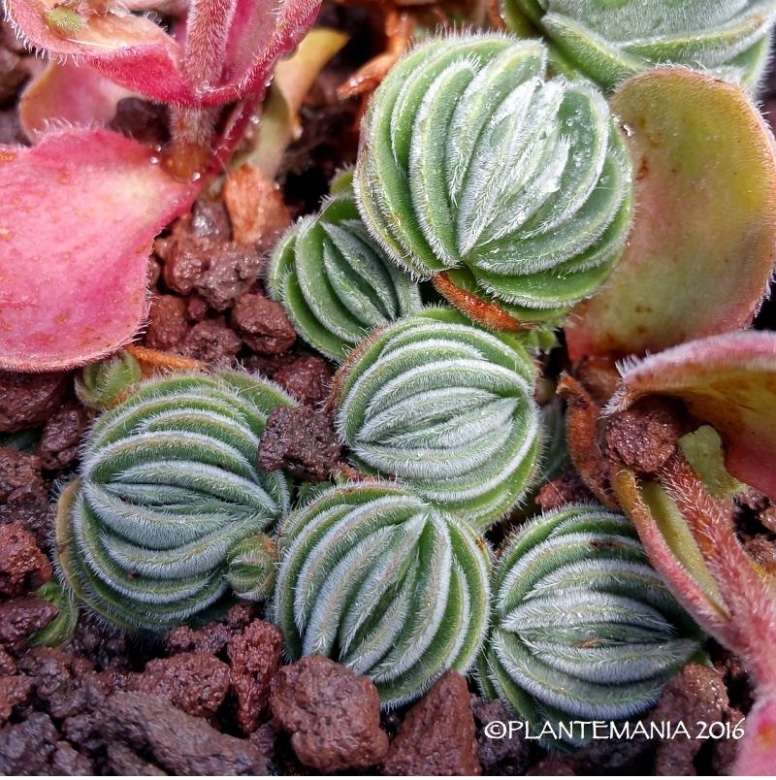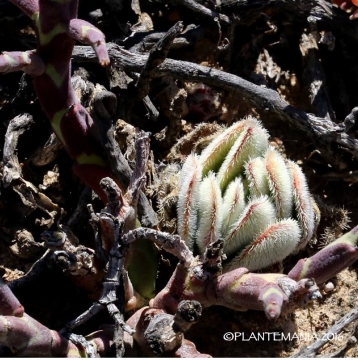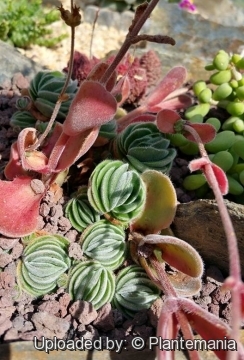Accepted Scientific Name: Crassula tomentosa Thunb.
Nova Acta Phys.-Med. Acad. Caes. Leop.-Carol. Nat. Cur. 6: 329 1778.

Turgosea tomentosa (Crassula tomentosa) Photo by: © Plantemania
The plant dies after flowering but it does form multiple heads, so some of these will continue even if the main head dies.
Origin and Habitat: Southern Namibia and Republic of South Africa (Northern Cape, Western Cape).
Habitat and ecology: Succulent and Nama Karoo. This species grows on stony slopes together with other succulent species such as, Euphorbia mauritanica, Pelargonium crithmifoliumSN|35424]]SN|35424]], Othonna cylindrica, Tylecodon paniculatusSN|33415]]SN|33415]], Crassula muscosa, Conophytum bilobumSN|1166]]SN|1166]], Ornithogalum multifolium, and Sarcostemma viminaleSN|27584]]SN|27584]].
Synonyms:
See all synonyms of Crassula tomentosa
back
Accepted name in llifle Database:Crassula tomentosa Thunb.Nova Acta Phys.-Med. Acad. Caes. Leop.-Carol. Nat. Cur. 6: 329 1778.Synonymy: 10
Accepted name in llifle Database:Crassula tomentosa var. glabrifolia (Harv.) G.D.RowleyCact. Succ. J. Gr. Brit. 40: 53 1978.Synonymy: 7
back
Common Names include:
ENGLISH: woolly crassula
Description: Crassula tomentosaSN|33568]]SN|33568]], or woolly crassula, is a perennials or biennials succulent with one to few, rarely many rosettes, compact rosettes of greyish green leaves to 60 cm tall (including the inflorescence). Everywhere is densely clothed with rigid, reflexed bristly-hairs. It is monocarpic that is to say that its individual rosettes flower only once in their life, set seeds and then die. Crassula tomentosaSN|33568]]SN|33568]] is a very variable species (especially in hairiness and size and shape of leaves) with many slightly different forms.
Rosettes: Solitary or proliferating from the base to form small groups with with leaf pairs spirally arranged but often apparently two-ranked when young and with old leaves remaining attached to stems.
Leaves: Radical leaves 2-10 cm long, 1-3.5 cm broad, flattened, very variable in shape, broadly oblong, oblanceolate, obovate or orbicular, often 2-ranked and in a dense basal rosette, grey-green to green, glabrous, tomentose to rugose and with marginal cilia, tip rounded, truncate or acute; the cauline narrow-oblong, all densely hirsuto-setose and ciliate.
Root: Fibrous, somewhat woody.
Inflorescence: Terminal branched spike-like thyrses. Stem erect, robust, tapering upwards, to 10-60 cm tall simple, robust, densely leafy at base, with distant leaf-pairs above, the upper leaves diminishing to bracts or abortive. Flowers spreading in sessile decussate, densely clustered dichasia (flower clusters) at the nodes, lower dichasia pedunculate, forming a long interrupted spiked-thyrsus or spike. Peduncle covered with leaf-like bracts becoming smaller upwards.
Flowers: Sepals 2,5-3 mm long, linear, obtuse, stiffly hairy and ciliate, round-backed, fleshy, green. Corolla tubular, fused basally for 1-1,5 mm, white to yellowhis. Petals 2,5-4.5 mm long, oblong-panduriform, fused in the lower parts, gradually tapering into a channelled apex, tips spreading slightly recurved. Stamens with black anthers. Stigma subsessile. Squamae (nectary scales) oblong to square or rarely transversely oblong, 0,3-1,2 mm long, 0,2-l mm broad, truncate and more or less constricted downwards, scarcely fleshy, yellow.
Blooming season: Crassula tomentosaSN|33568]]SN|33568]] flowers early to mid-summer.
Subspecies, varieties, forms and cultivars of plants belonging to the Crassula tomentosa group
 Crassula tomentosa Thunb.: (var. tomentosa) Distribution. S Namibia and South Africa (Northern Cape, Western Cape)
Crassula tomentosa Thunb.: (var. tomentosa) Distribution. S Namibia and South Africa (Northern Cape, Western Cape)- Crassula tomentosa var. glabrifolia (Harv.) G.D.Rowley: Smaller, to 30 cm (incl. Inf); Ros densely branched, tight; Leaves less than 15 mm long, with truncate tips. Distribution: Northern Cape, Western Cape.
Bibliography: Major references and further lectures
1) Urs Eggli “Illustrated Handbook of Succulent Plants: Crassulaceae” Springer Berlin Heidelberg, 05/Nov/2012
2) W. H. Harvey “Flora Capensis”, Vol 2, 1894
3) J.P. Roux “Flora of South Africa” 2003
4) Vinay Shah “Succulents from the Winter Rains” British Cactus & Succulent Society - Southampton & District Branch Newsletter, April 2010
 Crassula tomentosa in habitat. (Crassula tomentosa) Photo by: © Plantemania
Crassula tomentosa in habitat. (Crassula tomentosa) Photo by: © Plantemania Turgosea tomentosa (Crassula tomentosa) Photo by: © Plantemania
Turgosea tomentosa (Crassula tomentosa) Photo by: © PlantemaniaCultivation and Propagation: Crassula tomentosaSN|33568]]SN|33568]] is a one of the most frustrating species to grow, but properly grown, in a compost that is not too rich, in a good light, and not overwatered, a single rosette will become a beautiful sight as the leaves curve inwards and the plant assumes the appearance of a hairy ball. They are often grown in small bonsai pots.
Growth rate: It is a pretty fast grower.
Soil: Plants grow well in a well-drained mineral soil.
Pots: It needs a relatively shallow pot to accommodate its fibrous roots and provide a very good drainage.
Exposure: It cannot take direct sun in summer, too much sunshine and the leaves will scorch, but generally needs sun part of the day to bloom. In deep shade it gets pretty weak and eventually rots and dies. As houseplants, give crassulas up to 6 hours a day of sun.
Watering: It needs moderate water – not too wet nor too dry from autumn to spring with regular water in summer (careful watering required in winter), insufficient water and they will shrivel; too much water and the rosette will open up into a hairy cabbage.
Fertilization: Light fertilizer seems to boost its growth whenever additional water is given. Feed it during the growing season with a fertilizer specifically formulated for cactus and succulents (high potash fertilizer with a dilute low nitrogen), including all micro nutrients and trace elements diluted to ½ the strength recommended on the label. It thrive in poor soils and needs a limited supplies of fertilizer to avoid the plant developing excess vegetation, which is easily attacked by fungal diseases.
Special need: Provide very good ventilation. Nearly all problems occur as a result of overwatering and poor ventilation, especially when weather conditions are dull and cool or very humid.
Pest and diseases: It does not suffer from pests, other than the occasional mealybugs. Protect against frost.
Hardiness: Outdoors in frost free areas, indoors all other zones.
Propagation: Seeds/Offsets. Sow seeds in autumn. Place cuttings in clean river sand, mist every three to four days, roots should appear within 2-3 weeks.













